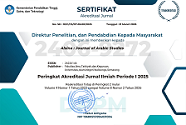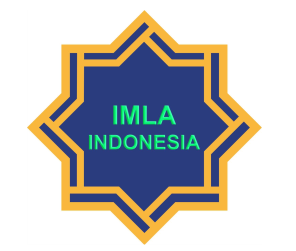Kahoot Gamification: Fostering Critical Thinking in Arabic Listening Comprehension
Abstract
In this digital transformation era, education is also urgent to implement innovative pedagogical approaches that not only strengthen language competency but also systematically develop critical thinking skills. This study aims to reveal the use of Kahoot gamification in Arabic listening skills, which implicitly creates a process of critical thinking skills in students. This critical thinking ability is produced by students during the learning process, by paying attention to indicators based on Facione. This qualitative study has an instrumental case study design, focusing on a single case with descriptive data. The data was collected through participatory observation and documentation carried out on 120 Syariah students, using interactive model data analysis techniques to identify Kahoot gamification that had been developed and implemented. The results of this study revealed that the use of Kahoot gamification includes four learning activities that bring out critical thinking aspects in learning Arabic listening skills, namely: a) song playback, including analysis, inference, and self-regulation; b) simple dialogue, including analysis, evaluation, inference, explanation, and self-regulation; c) short films and short stories, including interpretation, evaluation, explanation, and self-regulation. Critical thinking during Arabic language learning supports student engagement to be more confident, open-minded, and develop.
Downloads
References
Aibar-Almazán, Agustín, Yolanda Castellote-Caballero, María del Carmen Carcelén-Fraile, Yulieth Rivas-Campo, and Ana María González-Martín. “Gamification in The Classroom: Kahoot! As a Tool for University Teaching Innovation.” Frontiers in Educational Psychology 15 (2024). https://doi.org/10.3389/fpsyg.2024.1370084.
Al-Mutairi, Tariq G. “Inspecting The Role of Learning Platforms, Gamification, and Diverse Teaching Approaches in Improving Vocabulary Acquisition, Critical Thinking, and Student Engagement in Education.” Journal of Research Studies in English Language Teaching and Learning 2, no. 5 (2024): 283–95. https://doi.org/10.62583/rseltl.v2i5.59.
Alamer, Abdullah, and Fakieh Alrabai. “The Causal Relationship between Learner Motivation and Language Achievement: New Dynamic Perspective.” Applied Linguistics 44, no. 1 (2023): 148–68. https://doi.org/10.1093/applin/amac035.
Aljebreen, Saad, and Aseel Alzamil. “The Impact of Using Short Films on Learning Idioms in EFL Classes.” World Journal of English Language 12, no. 7 (2022): 250–64. https://doi.org/10.5430/wjel.v12n7p250.
Almelhes, Sultan A. “Gamification for Teaching The Arabic Language to Non-Native Speakers: A Systematic Literature Review.” Frontiers in Education 9 (2024). https://doi.org/https://doi.org/10.3389/feduc.2024.1371955.
Angelelli, Claudia Viviana, Geisa Muller de Campos Ribeiro, Maico Raris Severino, Eilidh Johnstone, Gana Borzenkova, and Dayane Costa Oliviera da Silva. “Developing Critical Thinking Skills Through Gamification.” Thinking Skills and Creativity 49, no. September 2023 (2023): 101354. https://doi.org/10.1016/j.tsc.2023.101354.
Bağ, Hatice Kübra, and Esim Gürsoy. “The Effect of Critical Thinking Embedded English Course Design to The Improvement of Critical Thinking Skills of Secondary School Learners.” Thinking Skills and Creativity 41, no. September 2021 (2021): 100910. https://doi.org/10.1016/j.tsc.2021.100910.
Bai, Shurui, Khe Foon Hew, and Biyun Huang. “Does Gamification Improve Student Learning Outcome? Evidence from a Meta-Analysis and Synthesis of Qualitative Data in Educational Contexts.” Educational Research Review 30, no. June 2020 (2020): 100322. https://doi.org/10.1016/j.edurev.2020.100322.
Bennett, Michael Timothy. “On the Computation of Meaning, Language Models and Incomprehensible Horrors.” In Artificial General Intelligence, edited by P. Hammer, M. Alirezaie, and C. Strannegård, 24:32–41. Springer, Cham, 2023.
Chen, Meng, Mohammad Mohammadi, and Siros Izadpanah. “Language Learning Through Music on the Academic Achievement, Creative Thinking, and Self-Esteem of the English as a Foreign Language (EFL) Learners.” Acta Psychologica 247, no. July 2024 (2024): 104318. https://doi.org/10.1016/j.actpsy.2024.104318.
Chen, Xieling, Xinyue Li, Di Zou, Haoran Xie, and Fu Lee Wang. “Metacognition Research in Education: Topic Modeling and Bibliometrics.” In Educational Technology Research and Development, 2025. https://doi.org/10.1007/s11423-025-10451-8.
Dehghanzadeh, Hojjat, Hashem Fardanesh, Javad Hatami, Ebrahim Talaee, and Omid Noroozi. “Using Gamification to Support Learning English as a Second Language: A Systematic Review.” Computer Assisted Language Learning 34, no. 7 (2021): 934–57. https://doi.org/10.1080/09588221.2019.1648298.
Du, Jing, Guangtao Xu, Wenhao Liu, Dibin Zhou, and Fuchang Liu. “Enhancing Online Learning Through Multi-Agent Debates for CS University Students.” Applied Sciences 15, no. 11 (2025): 5877. https://doi.org/10.3390/app15115877.
Facione, Peter A. “Critical Thinking: What It Is and Why It Counts.” Insight Assessment 1, no. 1 (2011): 1–23. https://d1wqtxts1xzle7.cloudfront.net/71022740/what_why98-libre.pdf?1633192859=&response-content-disposition=inline%3B+filename%3DCritical_Thinking_What_It_Is_and_Why_It.pdf&Expires=1752554233&Signature=fJAuBOIOjfcSNRlF8PPBb6k31HwT4a~MWkB57B6n2kHbPZzf8FoR.
Huang, Lu, Xiuli Dong, Hang Yuan, and Lihua Wang. “Enabling and Inhibiting Factors of the Continuous Use of Mobile Short Video APP: Satisfaction and Fatigue as Mediating Variables Respectively.” Psychology Research and Behavior Management 16 (2023): 3001–17. https://doi.org/10.2147/PRBM.S411337.
James, Trixie, Hayley Griffin, Katrina S. Johnston, and Frank Armstrong. “Reflective Minds, Brighter Futures: Empowering Critical Reflection with a Guided Instructional Model.” Journal of University Teaching and Learning Practice 20, no. 6 (2023). https://doi.org/10.53761/1.20.6.9.
Jasni, Siti Rohani, Suahila Zailani, and Hakim Zainal. “Pendekatan Gamifikasi Dalam Pembelajaran Bahasa Arab.” JFatwa: Journal of Fatwa Management and Research 13, no. 1 (2018). https://doi.org/10.33102/jfatwa.vol13no1.165.
Kamsinah, Dessy Laila, Abdullah, and Suryajaya. “Analysis of Critical Thinking Skills in Junior High School Students.” Journal of Advances in Educational and Philosophy 4, no. 6 (2020): 234–37. https://doi.org/10.36348/jaep.2020.v04i06.002.
Khaldi, Amina, Rokia Bouzidi, and Fahima Nader. “Gamification of E-Learning in Higher Education: A Systemic Literature Review.” Smart Learning Environments 10, no. 10 (2023). https://doi.org/10.1186/s40561-023-00227-z.
Laird-Gentle, Alexandra, Kevin Larkin, Harry Kanasa, and Peter Grootenboer. “Systematic Quantitative Literature Review of The Dialogic Pedagogy Literature.” The Australian Journal of Language and Literacy 46 (2023): 29–51. https://doi.org/10.1007/s44020-022-00029-9.
Liang, Weijun, and Dennis Fung. “Fostering Critical Thinking in English-as-a-Second-Language Classrooms: Challenges and Opportunities.” Thinking Skills and Creativity 39, no. March 2021 (2021): 100769. https://doi.org/10.1016/j.tsc.2020.100769.
Lim, Nikki Zhi Li, Azrifah Zakaria, and Vahid Aryadoust. “A Systematic Review of Digital Storytelling in Language Learning in Adolescents and Adults.” Education and Information Technologies 27 (2022): 6125–55. https://doi.org/10.1007/s10639-021-10861-0.
Magno, Carlo. “The Role of Metacognitive Skills in Developing Critical Thinking.” Metacognition and Learning 5 (2010): 137–56. https://doi.org/10.1007/s11409-010-9054-4.
Matthew B. Miles; A. Michel Huberman; Johnny Saladana. Qualitative Data Analysis A Methods Sourcebook Edition 3. United States of America, 2014.
McGowan, Lucy D’Agostino, Roger D. Peng, and Stephanie C. Hicks. “Design Principles for Data Analysis.” Journal of Computational and Graphical Statistics 32, no. 2 (2023): 754–61. https://doi.org/10.1080/10618600.2022.2104290.
Petrusly, Fredik Lambertus Kollo, Marsi D. S. Bani, Tuatul Mahfud, and Zulkarnain. “The Effect of Gamification Using Kahoot on Students’ Critical Thinking Abilities: The Role of Mediating Learning Engagement and Motivation.” Educational Administration: Theory and Practice 30, no. 5 (2024). https://doi.org/10.53555/kuey.v30i5.1524.
Pingmuang, Pawarit, and Prakob Koraneekij. “Mobile-Assisted Language Learning Using Task-Based Approach and Gamification for Enhancing Writing Skills in EFL Students.” EJEL: The Electronic Journal of e-Learning 20, no. 5 (2022): 623–38. https://doi.org/10.34190/ejel.20.5.2339.
Ponna, Afra Siti Annisa, Asep Suratman, Hamdan Sugilar, and Rahayu Kariadinata. “Kemampuan Berpikir Kritis Melalui Metode Predict-Observe-Explain Berbantuan Aplikasi Kahoot.” Jurnal Perspektif 6, no. 1 (2022): 41–51. https://doi.org/10.15575/jp.v6i1.166.
Putz, Lisa-Maria, Florian Hofbauer, and Horst Treiblmaier. “Can Gamification Help to Improve Education? Findings from a Longitudinal Study.” Computers in Human Behavior 110, no. Septemper 2020 (2020): 106392. https://doi.org/10.1016/j.chb.2020.106392.
Sarwanto, Laksmi Evasufi Widi Fajari, and Chumdari. “Critical Thinking Skills and Their Impacts on Elementary School Students.” Malaysian Journal of Learning and Instruction 18, no. 2 (2021): 161–87. https://doi.org/10.32890/mjli2021.18.2.6.
Scrivener, Jim. Learning Teaching. 2nd ed. Oxford: Macmillian Education LTD, 2005. https://jonturnerhct.wordpress.com/wp-content/uploads/2015/08/learning-teaching-by-james-scrivener.pdf.
Thurairasu, Vanitha. “Gamification-Based Learning as The Future of Language Learning: An Overview.” EJ-Social: European Journal of Humanities and Social Sciences 2, no. 6 (2022): 62–69. https://doi.org/10.24018/ejsocial.2022.2.6.353.
Veen, Mario. “Creative Leaps in Theory: The Might of Abduction.” Advances in Health Sciences Education 26 (2021): 1173–83. https://doi.org/10.1007/s10459-021-10057-8.
Yabukoshi, Tomoko. “Self-Regulation and Self-Efficacy for the Improvement of Listening Proficiency Outside the Classroom.” The Language Learning Journal 49, no. 1 (2021): 27–40. https://doi.org/10.1080/09571736.2018.1472626.
Yin, Robert K. Studi Kasus: Desain & Metode. Jakarta: PT Raja Grafindo Persada, 2012.
Zoting, Shivani. “E-Learning Services Market Size and Forecast 2025 to 2034.” Precedence Research, June 27, 2025. https://www.precedenceresearch.com/e-learning-services-market#:~:text=The global E-learning services,share of 37%25 in 2024.
Published
How to Cite
Issue
Section
License

This work is licensed under a Creative Commons Attribution-NonCommercial-ShareAlike 4.0 International License.
Copyright
The copyright of the received article shall be assigned to the publisher of the journal. The intended copyright includes the right to publish the article in various forms (including reprints). The journal maintains the publishing rights to published articles. Authors are allowed to use their articles for any legal purposes deemed necessary without written permission from the journal, but with an acknowledgment to this journal of initial publication.
Licensing
In order for Alsina: Journal of Arabic Studies to publish and distribute research articles, the editors need publishing rights (transferred from author to publisher). This agreement relates to the transfer/publishing copyright license to Alsina: Journal of Arabic Studies but the authors still have significant rights to use and share their published articles.
Alsina: Journal of Arabic Studies supports the need for writers to share, disseminate and maximize the impact of their research and their rights on any database. As a journal article writer, you have the right to various uses of your articles, including that by the institution or company where you work. Copyright can be used without the need for special permission. Authors who publish articles in the Alsina: Journal of Arabic Studies have broad rights to use their work for teaching and scientific purposes without requesting permission, including:
- Use by the author for lectures, presentations, or conferences, with distribution of copies to participants;
- Distribution to colleagues for research use;
- Use in compilations of the author's subsequent work;
- inclusion in a thesis or dissertation;
- Reuse of sections or excerpts from articles in other works (with full acknowledgment of the final article);
- Preparation of derivative works (other than commercial purposes) (with full acknowledgment of the final article);
- Voluntary posting on open websites operated by authors’ or writers' agencies for scientific purposes
When submitting a manuscript, authors do so on the understanding that if accepted for publication, the copyright for publishing (publishing right) of the article shall be assigned/transferred to Alsina: Journal of Arabic Studies.
Authors whose articles are accepted for publication will receive confirmation via email and sent a Copyright Transfer Agreement.

 Accreditation
Accreditation 
 In Collaboration with
In Collaboration with 

 Visitors
Visitors  Article Template
Article Template





